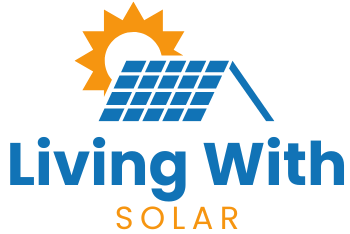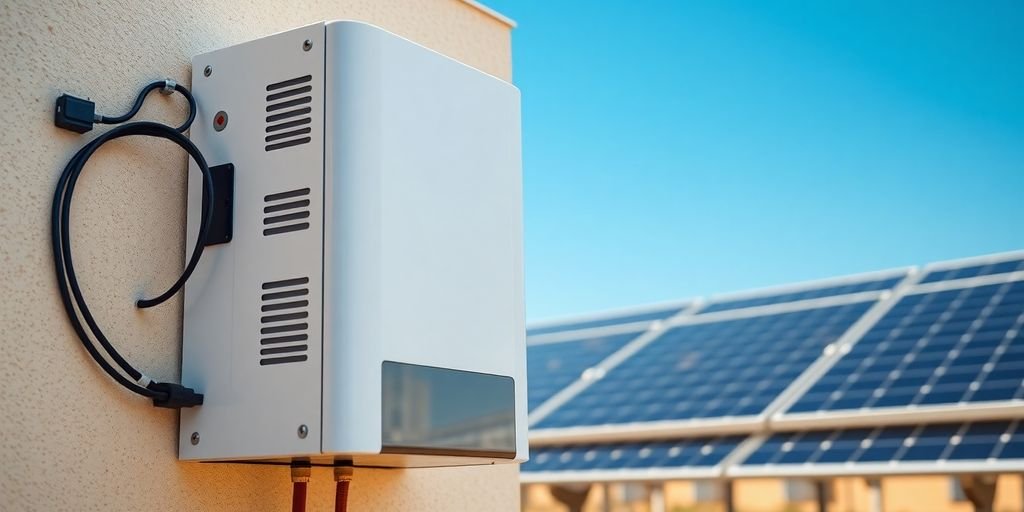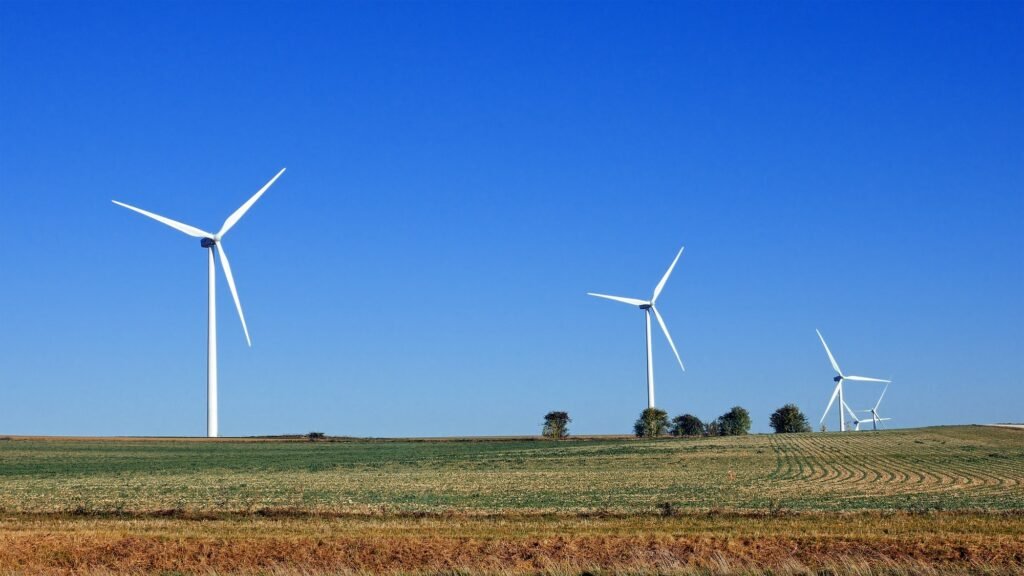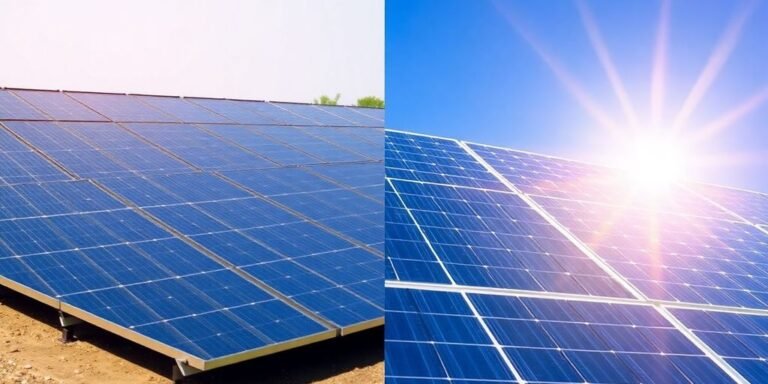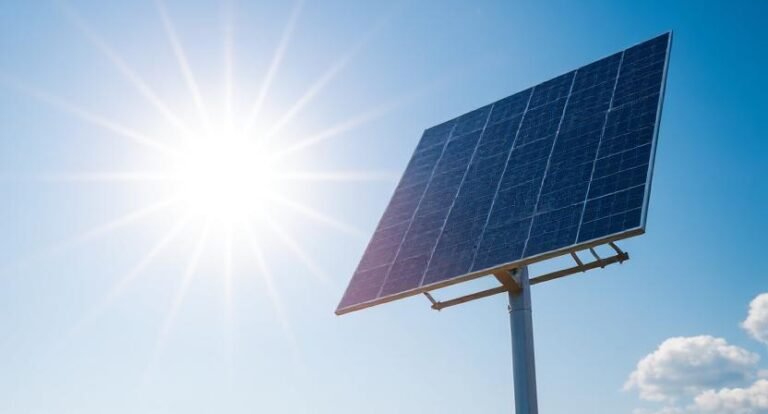If you’ve ever wondered how solar panels actually power your home, the answer lies in a little device called a solar inverter.
This piece of technology plays a vital role in converting the energy collected from sunlight into a form that we can use in our everyday lives.
In this article, we’ll break down what a solar inverter is, how it works, and why it’s so important for solar energy systems.
Key Takeaways
- 🔌 Solar inverters convert direct current (DC) from solar panels into alternating current (AC) for home use.
- ⚡ They can be grid-tied, allowing excess energy to be sent back to the power grid.
- 🧩 Different types of solar inverters include string inverters, microinverters, and power optimizers.
- 📈 Using a solar inverter helps maximize energy production and monitor system performance.
- 🚨 Common issues with solar inverters can include overheating and failure to convert power efficiently.
Introduction to Solar Inverters

So, you’re thinking about solar panels? Great! But before you install a home solar panel system, there’s something else super important to understand: the solar inverter.
It’s not as flashy as the panels themselves, but honestly, it’s the brains of the whole operation. Without it, your solar panels are basically just expensive decorations. The solar inverter is what makes the power from your panels usable in your home.
Think of it this way: solar panels generate electricity, but it’s a specific type called direct current (DC). Most of our homes run on alternating current (AC). The inverter’s job is to take that DC electricity and convert it into AC electricity. It’s like a translator, taking the language of the sun and making it understandable for your appliances.
I remember when I first started looking into solar, I was totally confused by all the different components. It seemed like a lot of technical stuff, but once you break it down, it’s not too complicated. The inverter is a key piece of the puzzle, and understanding what it does is the first step to making solar energy a smart choice for your home. It’s also important to consider inverter solar systems when planning your solar installation.
Solar inverters are a critical component in any solar panel system. They ensure that the electricity generated by your panels can actually be used to power your home. Without a properly functioning inverter, your solar investment won’t pay off.
What is a Solar Inverter?

So, what exactly is a solar inverter? Well, in simple terms, a solar inverter is the device that converts the direct current (DC) electricity generated by your solar panels into alternating current (AC) electricity, which is what your home appliances use. Think of it as the translator between your solar panels and your household.
I like to think of it this way: your solar panels are like a foreign power plant, speaking a different electrical language (DC). The inverter is the interpreter, making sure everything your house needs to run understands what the panels are saying. Without it, you’d have a bunch of unused solar energy just sitting there. It’s a pretty important piece of the solar energy puzzle.
It’s more than just a simple converter, though. Modern inverters also do things like monitor your system’s performance, maximize energy production, and even communicate with the utility grid. They’re like the brains of your solar setup, making sure everything runs smoothly and efficiently.
How do Solar Inverters Work
Solar inverters are essential for converting the direct current (DC) electricity produced by solar panels into alternating current (AC), which is the standard electricity used in homes and businesses. The inverter essentially tricks the transformer into thinking that the DC is actually AC, by forcing it to act in a way like AC – the inverter runs the DC through two or more transistors that turn on and off super fast and feed two varying sides of the transformer.
Conversion of DC to AC Power
Okay, so your solar panels are soaking up the sun and creating DC electricity. Great! But your TV, fridge, and all those other gadgets? They need AC. That’s where the inverter steps in. It takes that DC power and flips it back and forth, creating the AC power your home can actually use. It’s a pretty neat trick, and modern inverters are super efficient at it. Some can convert DC to AC with efficiency ratings up to 97%!
Grid-Tied vs. Off-Grid Inverters
Now, there are a couple of different types of inverters, depending on how your solar system is set up. If you’re connected to the grid (which most people are), you’ll have a grid-tied inverter. This type of inverter not only converts the DC to AC, but it also syncs up with the grid’s frequency and voltage. This allows you to send excess power back to the grid and even draw power from the grid when your solar panels aren’t producing enough. If you live in an area with net metering, this can earn you credits that reduce your energy bill.
On the other hand, if you’re completely off-grid, you’ll need a different type of inverter that’s designed to work with batteries. These inverters create their own AC power source and manage the charging and discharging of your batteries. They’re a bit more complex, but they give you complete energy independence. The type of solar inverter you get installed at your house will be determined by several factors, including the shape and complexity of your roof.
How does Solar Inverters Work
Okay, so you’ve got solar panels soaking up the sun, but how does that energy actually power your TV or charge your phone? That’s where the solar inverter comes in. It’s basically the translator between your solar panels and your home’s electrical system. Let’s break it down.
Conversion of DC to AC Power
Solar panels generate electricity in the form of direct current (DC). Think of DC as electricity flowing in one direction, like a river. But most of our homes and the electrical grid use alternating current (AC), where the electricity flows back and forth. The inverter’s main job is to convert that DC power into AC power.
I like to think of it this way:
- DC Power: Straight line, one direction. Good for batteries.
- AC Power: Wavy line, changes direction. Good for homes and the grid.
Inside the inverter, there are some pretty cool electronic components that rapidly switch the direction of the DC current. This “tricks” the electricity into becoming AC. It’s a bit like turning a water wheel really fast to create waves instead of a steady stream. The inverter also makes sure the AC power is at the right voltage and frequency to match what your appliances need and what the grid uses. If you want to learn more, you can read about solar energy systems.
Grid-Tied vs. Off-Grid Inverters
Not all inverters are created equal. The type you need depends on whether you’re connected to the electrical grid or living off-grid.
- Grid-Tied Inverters: These are the most common. They send excess solar power back to the grid, and you can draw power from the grid when your solar panels aren’t producing enough. It’s a two-way street. These inverters have to sync up with the grid’s frequency and voltage, and they usually shut down automatically if the grid goes down (for safety reasons).
- Off-Grid Inverters: If you’re not connected to the grid, you need an off-grid inverter. These inverters work with batteries to store solar power for later use. They create their own AC power source and don’t need to sync with the grid. They’re more complex and often more expensive than grid-tied inverters. You can also look into solar inverters for more information.
Choosing the right inverter is a big deal. It affects how efficiently your solar system works and how reliable your power supply is. Think about your energy needs and whether you want to be connected to the grid before making a decision.
| Feature | Grid-Tied Inverter | Off-Grid Inverter |
|---|---|---|
| Grid Connection | Required | Not Required |
| Battery Storage | Optional | Required |
| Complexity | Simpler | More Complex |
| Cost | Lower | Higher |
| Power Outage Use | Limited | Yes |
Types of Solar Inverters
Okay, so you’re getting serious about solar. That’s awesome! One of the things I had to wrap my head around was the different types of solar inverters. It’s not just a one-size-fits-all kind of deal. There are a few main types, and each has its own pros and cons. Knowing the difference can really help you make the right choice for your home solar panel system.
String inverters are like the OGs of the solar world. They’ve been around for a while, and they’re still a pretty common choice. Basically, you connect a bunch of solar panels in a series, like Christmas lights, and that “string” of panels feeds into a single inverter. The inverter then converts all that DC electricity into AC electricity that you can use in your home.
Here’s the thing: if one panel in the string is shaded or has some kind of issue, it can affect the performance of the whole string. It’s like if one Christmas light goes out, they all go out (well, not anymore with modern lights, but you get the idea!).
- ✅ Simple and relatively inexpensive
- ✅ Easy to install and maintain
- ✅ Good for systems where all panels get equal sunlight
String inverters are a solid choice if you have a simple roof with no shading issues. They’re reliable and cost-effective, but they might not be the best option if your roof is complex or has trees casting shadows.
Microinverters are a bit newer to the scene, and they’re pretty cool. Instead of having one big inverter for all your panels, you have a small inverter attached to each individual panel. This means that each panel operates independently. So, if one panel is shaded, it doesn’t affect the performance of the others. Think of it as each light in the string having its own power source.
- ✅ Panel-level monitoring: You can see how each panel is performing
- ✅ Better performance in shaded conditions
- ✅ More flexible design options
Microinverters are great, but they do come with a higher upfront cost. However, the increased performance and monitoring capabilities can make them worth it, especially if you have shading issues or a complex roof.
You can compare microinverters and string inverters to see which is best for you.
Power optimizers are a kind of hybrid between string inverters and microinverters. You still have a central string inverter, but you also have a little device attached to each panel that optimizes its output. These optimizers condition the DC power before sending it to the inverter, maximizing the amount of energy you get from each panel. It’s like giving each light in the string a little boost to make sure it shines its brightest.
- ✅ Increased energy production compared to string inverters
- ✅ Panel-level monitoring (though sometimes not as detailed as with microinverters)
- ✅ Lower cost than microinverters
Power optimizers can be a good middle ground if you want some of the benefits of microinverters without the higher price tag. They’re a good option for roofs with some shading or complex angles.
If you run into inverter issues, knowing your system type helps. Here’s a guide on 5 everyday inverter problems to help troubleshoot.
Benefits of Using Solar Inverters

Okay, so we’ve talked about what solar inverters are and how they work. Now, let’s get into why you should even care. For me, the benefits are a big deal, and they’re what really sold me on getting solar panels in the first place.
Maximizing Energy Production
A good solar inverter can really help you get the most out of your solar panels. They’re designed to track the voltage from your panels and optimize the efficiency of your whole renewable solar energy system. I was surprised to learn that modern inverters can convert DC power to AC with efficiencies up to 97%! That’s a lot of power saved.
Monitoring System Output
I love being able to see how much energy my panels are generating. It’s kind of addictive to watch those numbers climb on a sunny day. Most modern inverters let you do this through a mobile app or website. I can see exactly how much power I’m producing at any given moment, and I can also check historical data to see how my system is performing over time.
It’s also great for peace of mind, knowing that the system is working as expected. Plus, many inverters run system performance checks and will alert you if there are any issues. This helps me verify that all components are working and generating the expected amount of electricity.
Communicating with the Utility Grid
If you’re like me, you might have times when your solar panels are generating more electricity than you’re using. That’s where the inverter comes in again. It can seamlessly feed that extra power back into the grid. If you live in an area with net metering, you can even get credits on your energy bill for the excess power you send back.
It’s like getting paid to feed excess power to the grid! Also, during a power outage, some inverters can isolate your home from the grid, keeping your lights on while protecting utility workers from the electricity your panels are producing.
I think one of the most understated benefits is the peace of mind that comes with knowing your system is being monitored and protected. It’s not just about saving money; it’s about having a reliable and safe energy source.
Fault Detection and Automatic Shut-Off
Electrical safety is a big deal, and solar inverters play a key role here. They’re designed to detect potential electrical hazards, like ground faults or arcs. If something goes wrong, the inverter will quickly shut down to protect the system and alert you to the problem. This is especially important with aging electrical wiring or solar equipment.
Correct installation by a professional is key to ensuring a long, safe, and productive life for your system. I also learned that MPPT inverters enhance energy extraction from solar panels, leading to increased efficiency and better power output.
Common Issues with Solar Inverters
Okay, so solar inverters are pretty cool, but they’re not perfect. Like any piece of tech, they can have their share of problems. I’ve seen a few issues pop up over time, and it’s good to know what to look out for. Let’s get into it.
One of the most common problems I see is related to the actual conversion process. The inverter is supposed to efficiently change DC power from your solar panels into AC power for your home, but sometimes it just doesn’t do it well. This can manifest in a few ways:
- Reduced Efficiency: The inverter isn’t converting as much DC power to AC as it should, meaning you’re not getting the full benefit of your solar panels. This can be due to component aging or internal faults.
- Power Fluctuations: The AC power output is unstable, causing lights to flicker or sensitive electronics to malfunction. This can be a sign of a failing capacitor or other internal issue.
- Complete Failure: The inverter stops converting power altogether, leaving you without solar energy. This could be due to a blown fuse, a faulty circuit board, or other major component failure.
If you are experiencing low efficiency, it might be time to call a professional.
Whether you’re connected to the grid or running off-grid can influence the types of problems you encounter. Grid-tied inverters have to play nice with the utility company’s power, and that can lead to some interesting issues. Off-grid inverters, on the other hand, have to be more robust and handle a wider range of conditions.
- Grid Voltage Errors: Grid-tied inverters need to match the voltage and frequency of the grid. If there’s a mismatch, the inverter might shut down or operate inefficiently. This is especially common during peak demand times when the grid voltage can fluctuate. It’s important to understand solar power and how it interacts with the grid.
- Overvoltage Shutdowns: If the grid voltage spikes too high, the inverter will shut down to protect itself and your home. This can be caused by lightning strikes, utility equipment failures, or other grid disturbances. These shutdowns can be frustrating, especially if they happen frequently.
- Isolation Faults: These are more common in damp weather. An isolation fault means that electricity is leaking to ground, which is a safety hazard. The inverter should detect this and shut down, but it’s still something to be aware of. If you live in a damp area, you might want to consider solar inverters designed for those conditions.
Keeping an eye on your inverter’s performance and addressing any issues promptly can save you a lot of headaches down the road. Regular maintenance and professional check-ups are a good idea to ensure your system is running smoothly and safely.
String inverters, while generally reliable, have their own set of potential problems. Because they handle the output of an entire string of solar panels, a problem with one panel can affect the whole system. Shading is a big one.
If even one panel is shaded, the output of the entire string can be reduced. This is a major drawback compared to microinverters or power optimizers, which can mitigate the effects of shading.
Also, because string inverters are typically located in a central location, they can be more susceptible to environmental factors like heat and moisture. This can lead to premature failure or reduced performance over time.
Microinverters, on the other hand, are installed on each individual solar panel. This means that shading or other issues affecting one panel won’t impact the performance of the rest of the system. However, microinverters also have their downsides.
They’re more expensive than string inverters, and because they’re located on the roof, they can be more difficult to access for maintenance or repairs. Also, because there are more of them (one for each panel), there’s a higher chance that one will fail over time.
Replacing a microinverter can be a hassle, requiring a professional to come out and remove the panel. It’s important to weigh the pros and cons of each type of inverter before making a decision.
Power optimizers are a hybrid approach that combines some of the benefits of both string inverters and microinverters. They’re installed on each panel like microinverters, but instead of converting DC to AC on the roof, they optimize the DC power before sending it to a central inverter.
This can improve performance in shaded conditions and allow for more flexible system designs. However, power optimizers also add complexity to the system, and like microinverters, they can be more expensive than string inverters.
They also require a compatible inverter, which can limit your options. Ultimately, the best type of inverter for you will depend on your specific needs and circumstances.
Frequently Asked Questions
What is a solar inverter?
A solar inverter is a device that changes the electricity produced by solar panels from direct current (DC) to alternating current (AC). This is important because most home appliances use AC electricity.
How does a solar inverter work?
Solar inverters take the DC electricity generated by solar panels and convert it into AC electricity. They do this by switching the direction of the current back and forth very quickly, making it usable for your home.
What are the different types of solar inverters?
There are a few types of solar inverters, including string inverters, microinverters, and power optimizers. Each type has its own advantages depending on your solar setup.
Why do I need a solar inverter?
You need a solar inverter because it allows the electricity from your solar panels to be used in your home. Without it, you wouldn’t be able to power your appliances.
Can solar inverters help save money?
Yes! Solar inverters can help you save money by allowing you to use solar energy instead of buying electricity from the grid. Some systems can even sell excess energy back to the grid.
What issues can occur with solar inverters?
Common problems with solar inverters include overheating, communication errors, and general wear and tear. Regular maintenance can help prevent these issues.
